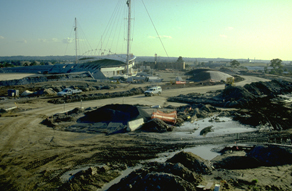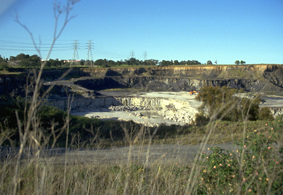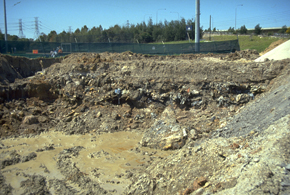When Sydney won its bid to host the Olympic Games in the year 2000, it hyped the Games as the “greenest” summer Olympics of all time. But a massive toxic waste dump lies underneath the fine landscaping of the Olympic site at Homebush Bay. The dump is covered by a metre of dirt and a mountain of public relations.
 Homebush Bay is a former industrial site and armaments depot which, before its transformation, was subjected to years of unregulated waste dumping. Asbestos-contaminated waste and chemicals including dioxins and pesticides had been found there, along with arsenic, cadmium, chromium, copper, lead, mercury and zinc. It was the worst toxic waste dump in Australia, and the bay into which the waste leached was so contaminated that fishing in it was banned. The sediments in the bay had concentrations of dioxin that made it one of the world’s worst dioxin hot spots.
Homebush Bay is a former industrial site and armaments depot which, before its transformation, was subjected to years of unregulated waste dumping. Asbestos-contaminated waste and chemicals including dioxins and pesticides had been found there, along with arsenic, cadmium, chromium, copper, lead, mercury and zinc. It was the worst toxic waste dump in Australia, and the bay into which the waste leached was so contaminated that fishing in it was banned. The sediments in the bay had concentrations of dioxin that made it one of the world’s worst dioxin hot spots.
What is impressive, in PR terms, is the way this massive toxic waste site has been transformed into a “green showcase”, thanks in large part to the endorsement of Greenpeace and other key Australian environmentalists.
 In 1989, Australian government authorities decided to use Homebush Bay as the site for a future Olympic Games. Even the chance of winning an Olympic bid, however, could not justify spending the $190 million that experts estimated it would cost to contain and treat the toxic wastes buried there. The government therefore sought a cheaper, more modest remediation strategy that could be carried out in time for the 1993 Olympic bid.
In 1989, Australian government authorities decided to use Homebush Bay as the site for a future Olympic Games. Even the chance of winning an Olympic bid, however, could not justify spending the $190 million that experts estimated it would cost to contain and treat the toxic wastes buried there. The government therefore sought a cheaper, more modest remediation strategy that could be carried out in time for the 1993 Olympic bid.
Authorities considered various options for dealing with the wastes. One possibility was to segregate and treat the wastes, but this would have been difficult and expensive.
Another possibility would have been to take a “bank vault” approach—sealing up and walling in the wastes. This approach would have entailed tightly containing the contaminated soil with double liners beneath, soil capping over the top, leachate drains, and gas collection and treatment systems. This approach was tried for a badly contaminated embankment where the Olympic swimming facility was to be built, but the planners decided that it was too expensive to be used elsewhere.
 A third, cheaper option was chosen for the rest of the site. It eliminated the gas collection and treatment systems and the double liners. This option meant that the wastes would continue to leak into underlying groundwater. A consultant to the government explained the reasoning behind this approach:
A third, cheaper option was chosen for the rest of the site. It eliminated the gas collection and treatment systems and the double liners. This option meant that the wastes would continue to leak into underlying groundwater. A consultant to the government explained the reasoning behind this approach:
The liability associated with deterioration and or failure of a “bank vault” secure landfill remained constant with time, but its probability of occurrence increased with time as the facility aged. By contrast the leaky landfill would over time carry less liability as the quality of leachate eventually improved. Therefore it is an intrinsically more robust or resilient way of limiting risks.
In other words, the waste would be disposed of by letting it slowly leak into the surrounding environment, rather than by alternative means that carried the risk of a financial liability that might be incurred by a possible sudden and more traceable major failure in the future.
In public discussions, however, these cost and liability issues were not raised. Instead, the public was told that the leaky landfill was the only feasible option, given the difficulty of treating the diverse range of chemicals that were present on the site. The option of a more secure “bank vault” landfill was not discussed outside of consultants’ reports.
By choosing the leaky landfill option, the planners were able to reduce the cost of remediation of the Olympic site from $190 million to $69 million, including landscaping and road base preparations. This enabled most of the remediation to be completed by 1993, in time for Sydney to win the bid for the 2000 Olympic Games.
Australian guidelines are quite explicit about the public’s right to know and participate in decision-making about the clean-up of contaminated sites. The remediation work at Homebush Bay, however, was carried out without proper public consultation. The government’s reports on contamination at the site and the risks associated with it have not been published. In their place are newsletters and brochures produced for public relations purposes.
In 1992, when the remediation was already underway, a local environmental group conducted a survey which found that seventy-one per cent of the respondents felt that they were not getting enough information to form an opinion about what was being done in the Homebush Bay area. Roughly the same number—seventy-five per cent—-said they had not received enough information to satisfy them that the area would be safe for people to live and work.
The usual process in NSW for involving the public in such decisions is through the public and advertised display of an environmental impact statement (EIS), after which the public is able to make submissions. The mandatory requirement for such an EIS to be prepared was removed through the introduction of a new Regional Environmental Plan prepared by the NSW Department of Planning.
It gave the NSW Minister for Planning full authority to give consent for development of the area earmarked for Olympic facilities and allowed development of the contaminated land within the area—including landfilling, removal and reworking of filled material—to occur without the normal consultation process. The assistant director of planning at the NSW Department of Planning said the former plan was “too restrictive” because it caused delays in construction and prevented earthmoving on site because of fears of contamination. This would have hindered the construction of Olympic facilities.
The new Regional Environmental Plan angered some environmentalists. According to Jeff Angel, director of the Total Environment Centre, the plan allowed the government to be “a law unto itself. It is incredible that despite the concerns previously expressed by environmentalists that Sydney’s Green Olympic bid was all hot air, the government still felt it necessary to issue the REP in this form.”
On the day the bid was announced, the Regional Environment Plan came into effect, giving the minister powers to approve any development at Homebush Bay whether or not it was environmentally damaging. The head of Greenpeace at the time, Lynette Thorstensen, told the Herald that this was not a setback: “At this stage we are much more interested in seeing the green development up and running than having ourselves locked up in disputes about process.”
The urgency to get the Games ready without bothering about due process is something that the Olympic authorities undoubtedly appreciated. Public relations is a much simpler and more controllable process than genuine public consultation.
In the absence of true public participation, PR around the Homebush Bay site focused on vacuous media stunts and photo opportunities. A brochure by the Olympic Coordination Authority falsely described the remediation of the site as “world’s best practice.”
“Openness not the Australian way: Games chief” was the headline of the Sydney Morning Herald after the Sydney Olympic Coordination Authority continued to refuse to release documents relating to the tendering process for Olympic facilities. The Herald reported that the head of the Authority, David Richmond, had “said there was a commercial culture in Australia which made it difficult to release the information, even though similar documents were made public in the privately funded Olympic Games in Atlanta and Salt Lake City”.
The Australian media were effectively closed to criticism of the Sydney bid at this time. The Australian Centre for Independent Journalism published a special Olympic Edition of its newsletter Reportage which covered a number of stories that were not being covered in the general media. The Centre’s director, Wendy Bacon, noted that the few journalists who wrote critical stories had been “attacked as unpatriotic, eccentric, inaccurate and negative”. Meanwhile, public support for the bid had been mobilized using a “pervasive media and marketing exercise” which included putting the bid logo on milk cartons, car registration stickers, buses, and many other places.
The state government began releasing information about the contamination of the site to the media shortly after the bid had been won, carefully framing the information in terms of the clean-up. “Restoring Homebush Bay for the 2000 Olympics, billed as the biggest environmental repair job undertaken in Australia, is reversing decades of environmental abuse at a cost of $83 million,” reported an article in the Sydney Morning Herald, which went on to reassure the public that the clean-up would make the site perfectly safe.
After it was announced that Sydney would host the 2000 Games, the Freedom of Information Act for New South Wales was amended to ensure that Sydney Olympic committee documents could not be accessed. This decision was criticized by the NSW Ombudsman, who pointed out that the exemptions to the Act had been added without public consultation.
The amendment specifically denied the public access to contracts, proposals for the various Olympic facilities including the athletes’ village, the criteria for selecting contractors, progress reports, committee meetings, and public opinion surveys. Contractors who worked on the facilities had to sign a confidentiality agreement. Even the contract between the NSW government and the International Olympic Committee remained a state secret.
In 1996, Herald environment writer Murray Hogarth reported on the continuing secrecy surrounding the Games: “Though we are less than four years out and closing fast, there are five rings of secrecy enveloping key aspects of Sydney’s Olympics. They are the often-impenetrable International Olympic Committee (IOC), the State Government with its spin doctors, the 30-year Cabinet secrecy rules and the ban on Freedom of Information requests, SOCOG and its media Games-keepers, OCA’s ICAC-inspired probity requirements, and finally big business, with a tangled web of confidentiality agreements.”
In 1997, Nathan Vass of the Herald reported that the state government was considering setting up a multi-million dollar strategy to deal with an expected 5,000-or-so international non-accredited journalists who would be hanging around Sydney before and during the 2000 Games looking for stories. Such journalists, unlike the 15,000-or-so officially accredited journalists there to report on the sporting events, were likely to be the source of critical stories.
In preparation for this feared onslaught of scrutiny, the Olympics manager of the Australian Tourist Commission recommended a “crisis media management program” to deal with negative stories about the environment, the ozone layer and Aboriginal issues. The plan called for seeking money from Olympic sponsors to establish a centre to house and respond to such journalists, thereby ensuring that “the non-accredited media present Sydney in a very positive fashion”.
On 31 October 1998 the OCA also organized an “Olympic Neighbors Day.” Titled “The Big Clean-up,” the event took area residents on a tour of the nicely landscaped Olympic site, while avoiding mention of the toxic wastes buried underneath the new lawns and shrubbery that will be slowly contaminating these neighbours’ groundwater for years to come.
A number of revelations about dioxin on the Homebush site posed another public relations crisis for the Olympic Coordination Authority (OCA) in 1997. Colin Grant, OCA’s executive director of planning, environment and policy, publicly stated that the site did not contain any 2,3,7,8 TCDD (the most toxic form of dioxin). After this statement was proven false, the OCA was forced to “unreservedly” apologize for the “mistake”.
Hired by OCA as an “environmental special adviser,” Kate Short organized a series of forums in 1998 on “Dioxin and Beyond: Enhancing Remediation Strategies at Homebush.” In reality, the forums were carefully staged public relations events aimed at creating the appearance of public consultation without the openness that true public involvement would have required. Attendance was by invitation only, and the forums primarily showcased speakers dwelling on good news about the remediation.
Following the forum series, in what seemed like an attempt to give the forums a veneer of having been a real consultation, the Australian government announced that a further $11.6 million would be spent for an “enhanced remediation program” which would consist of validation, monitoring and “education and community development” involving school children, but no further treatment of the wastes.
As the pressure mounted for public disclosure of documents relevant to the Sydney bid, the Games promoters turned again to using the cover of a private company in order to maintain secrecy, claiming that its financial documents belonged to internal auditors who were a private firm and therefore exempt from Freedom of Information rules.
In the years following the winning of the bid, the story of the toxic-waste contamination of Homebush Bay was well covered by the Australian media and also received some international coverage, especially in Germany. But as journalists from throughout the world began arriving in Sydney to cover the Olympics, were they able to see through the “media management” that was being geared up to greet them?